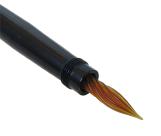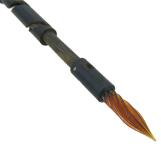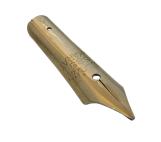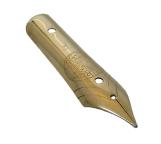Penexchange
- Home
- The "Cavalier of the Rose"
- Traveler's inkwell
- Fountain Pens for Use with Carbon paper
- Classifying Overlays
- The Toledo
- Why Piston Fillers !?
- Self-filling Pen
- The first Fountain Pens
- Many Brand Names - one Manufacturer
- Original Pelikan
- TULA-Silver-Overlays
- III. Series
- Pneumatik Fountain Pens
- How much would Grandmothers Fountain Pen be worth ?
- The Rappen-Fountain pen
- 400-400N-400NN
- IBIS 130E
Fountain Pens for Use with Carbon Paper
With the introduction of carbon paper for the production of duplicates, the desire to produce copies with fountain pens grew. Here the requirements stood in absolute contrast to the demands normally placed on a nib, i.e. precise strokes, flexible but not too soft.
To produce carbon copies a nib must be very hard in order to convey the necessary pressure when writing on paper. Under such pressure the tip of a standard nib would be forced apart so widely that the ink flow would be cut off.
The first pens which were designed for this purpose possessed a particularly hard "nib", whereby we cannot really speak of a nib in the ordinary sense, they were actually pen points. For example, around 1912 Kaweco offered a pen with an agate point. Later pen points of this kind were manufactured from glass and were fairly common.

safety pen with glass nib

mounted glass nib in
safety pen
These glass "nibs" were naturally not as versatile as ordinary nibs: the basic form was virtually cone-shaped with grooves running from the base to the point to transport the ink. Owing to the lack of flexibility of the glass, pressure could be applied as desired until the point broke off. This is why these glass nibs were available in packs of 6.
Montblanc also had glass nibbed pens in their assortment (safety pen "M.G. 400" and pushbutton pen "M.G. 420") which were furnished with a special engraving on the barrel.
The modified logo stood for "Montblanc Glass Nib Fountain Pen".
Later these glass nibs were made in the form of a standard nib. To prevent the nib points from splaying, various manufacturing techniques were employed, for example, Pelikan produced nibs for the model 100N whereby the material along the tines was much thicker. Optically, these nibs could not be distinguished from standard nibs. Alongside of the lack of flexibility and the absence of a stamp, which were indications of such nibs, it is noticeable that when dismantled, the nibs were much heavier.
The greater weight lead to a higher material price, therefore, a more inexpensive method of producing a comparable nib was contrived. To this purpose, the slot in the nib was significantly shortened so that the actual tine length was reduced. The modified tine length reduced splaying and the nib was decidedly harder than standard nibs. Since the position of the vent hole on Pelikan pens was a standard fixture a second vent hole had to be made at the end of the slot. However, nibs do exist with shortened slot and only one vent hole that is placed conspicuously to the front.

Pelikan nib for use with
carbon paper with one
vent hole

Pelikan nib for use with
carbon paper with 2
vent holes
Martin Lehmann